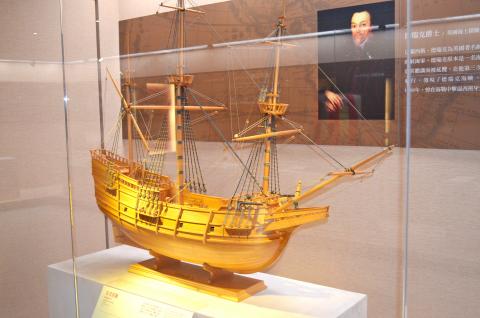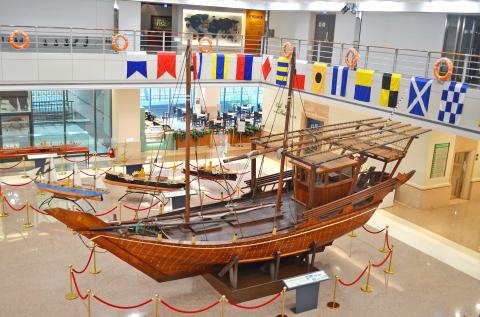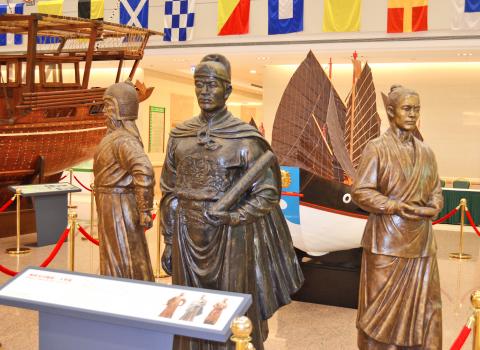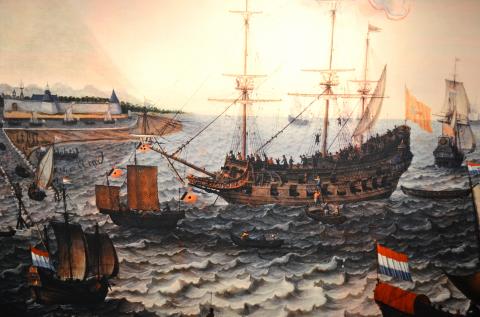“I must go down to the seas again, to the lonely sea and the sky, and all I ask is a tall ship and a star to steer her by.” So John Masefield opens Sea Fever, a poem in which he addresses our attraction, fascination and relationship with the sea — an attraction that the Chang Yung-Fa Foundation seeks to celebrate with its Evergreen Maritime Museum.
This must-see museum, which opened in 2008, houses some 4,000 maritime artifacts, paintings and nautical instruments that were in the private collection of Evergreen Group (長榮集團) Chairman and founder Chang Yung-fa (張榮發). Born on Penghu, Chang made his fortune in shipping and considers himself a “son of the ocean.” One of his philanthropic dreams was to create this educational museum.
A fascination with the sea is immediately apparent as you walk into the building’s lobby. Of the many ship models that greet visitors, three larger ones stand out. The largest is an Arabian dhow, such as those that plied the trade routes between India and the Arabian Peninsula. Beside that is a model of a treasure ship that would have been used by Chinese mariner Zheng He (鄭和, 1371-1435) and finally an authentic Orchid Island (蘭嶼, also known as Lanyu) caravel canoe fashioned by the Tao Aboriginal people.

Photo: Jerome Keating
TAIWAN’S MARITIME CULTURE
Given the country’s location, a maritime culture should be part of Taiwan’s history and destiny. Recent theories indicate that Austronesian culture originated from Taiwan 5,000 years ago and spread overseas reaching as far as Madagascar, New Zealand and Easter Island. Taiwan’s name, Ilha Formosa, came from Portuguese seafarers passing the island, while the Dutch and Spanish made it part of their overseas trade empires. Minnan and Hakka ancestors from China braved the Taiwan Strait to find a new life here. In short, this museum is a much-needed venue to redevelop and promote Taiwan’s maritime culture.
A brief HISTORY OF SHIPS

Photo: Jerome Keating
One starts on the fifth floor with the history of ships. Numerous models begin with Egyptian, Phoenician and Roman galleys as well as Viking long boats. With the Age of Sail come the caravel, the carrack and the galleon, all of which enabled Europeans to cross oceans, explore the world and reach Asia. Models include Sir Francis Drake’s galleon, the Golden Hind, which circumnavigated the globe from 1577 to 1580, Captain James Cook’s HMS Endeavor, the Mayflower, the French warship, Le Soleil Royal, the ill-fated Swedish Vasa, tea clipper and speed merchants like the Cutty Sark. These contrast with Chinese junks and Thai galleys.
The Age of Steam, diesel engines and propeller driven ships changed everything and so the fourth floor emphasizes modern ships including ocean liners, war ships and the cargo and container ships that made Evergreen famous. Stand out names include the Titanic, the Queen Mary, well known battleships like the Bismarck, Yamoto and Missouri, as well as air craft carriers, submarines and destroyers.
The third floor begins with a wide array of marine paintings from the pre-photography era when ships carried painters to capture and document dramatic sea experiences like storms, battles and port dockings. The floor topic then switches to focus on Taiwan’s role in sea history. Previous floors contrast Asian and Western shipping but here it is all Taiwan. Viewers learn the importance of Taiwan’s currents, trade ports, mapping and products.

Photo: Jerome Keating
NAVAL INSTRUMENTS
The pragmatic second floor gets down to the brass tacks of being at sea and all that is needed in navigation. Have you ever wanted to know how to read charts and star globes, use a sextant, determine latitude, understand ship flag communications and launch survival rafts? These are all found here as well as modern container ship wheelhouse, engine and chart room simulations. It is this floor that current Museum Director Captain Tyan Been-yuan (田本源), whose lifetime career has been the sea, feels most at home and “back on the bridge.”
At tour’s end, the lobby provides a small souvenir shop and cafe.

Photo: Jerome Keating
While historic reasons may have deterred Taiwan’s recent maritime culture, the bent of this museum aims to re-orient Taiwanese to the sea. It is a museum that not only every Taiwanese should visit, but also expats who wish to better understand how Taiwan’s location and past got it drawn into and became a part of the world of trade and commerce.
Evergreen Maritime Museum is located in the Chang Yung-fa Foundation Building (財團法人張榮發基金會國際會議中心), 1-5F, 11 Zhongshan S Rd, Taipei City (台北市中山南路11號1-5樓) . Open Tuesdays through Sundays from 9am to 5pm. On the Net: www.evergrenmuseum.org.tw

No one saw it coming. Everyone — including the Chinese Nationalist Party (KMT) — expected at least some of the recall campaigns against 24 of its lawmakers and Hsinchu Mayor Ann Kao (高虹安) to succeed. Underground gamblers reportedly expected between five and eight lawmakers to lose their jobs. All of this analysis made sense, but contained a fatal flaw. The record of the recall campaigns, the collapse of the KMT-led recalls, and polling data all pointed to enthusiastic high turnout in support of the recall campaigns, and that those against the recalls were unenthusiastic and far less likely to vote. That

Behind a car repair business on a nondescript Thai street are the cherished pets of a rising TikTok animal influencer: two lions and a 200-kilogram lion-tiger hybrid called “Big George.” Lion ownership is legal in Thailand, and Tharnuwarht Plengkemratch is an enthusiastic advocate, posting updates on his feline companions to nearly three million followers. “They’re playful and affectionate, just like dogs or cats,” he said from inside their cage complex at his home in the northern city of Chiang Mai. Thailand’s captive lion population has exploded in recent years, with nearly 500 registered in zoos, breeding farms, petting cafes and homes. Experts warn the

A couple of weeks ago the parties aligned with the People’s Republic of China (PRC), the Chinese Nationalist Party (KMT) and the Taiwan People’s Party (TPP), voted in the legislature to eliminate the subsidy that enables Taiwan Power Co (Taipower) to keep up with its burgeoning debt, and instead pay for universal cash handouts worth NT$10,000. The subsidy would have been NT$100 billion, while the cash handout had a budget of NT$235 billion. The bill mandates that the cash payments must be completed by Oct. 31 of this year. The changes were part of the overall NT$545 billion budget approved

The unexpected collapse of the recall campaigns is being viewed through many lenses, most of them skewed and self-absorbed. The international media unsurprisingly focuses on what they perceive as the message that Taiwanese voters were sending in the failure of the mass recall, especially to China, the US and to friendly Western nations. This made some sense prior to early last month. One of the main arguments used by recall campaigners for recalling Chinese Nationalist Party (KMT) lawmakers was that they were too pro-China, and by extension not to be trusted with defending the nation. Also by extension, that argument could be